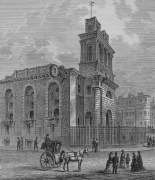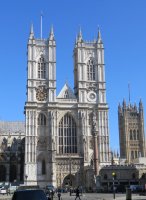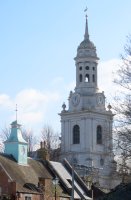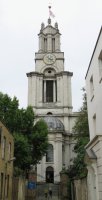Nicholas Hawksmoor (1661-1736)
St Mary Woolnoth, by Hawksmoor.
The architect Nicholas Hawksmoor, one of the most notable successors to Christopher Wren, designed Baroque churches and other buildings with a massiveness, an overwhelming, almost crushing weight and height and breadth of stone, that makes his work particularly distinctive. Even his smaller buildings give an impression of size and weight exceeding their size.
Nicholas Hawksmoor was born in Nottinghamshire, and worked for Wren from 1679, first as a clerk, then assistant, then deputy, supporting the master in his work on the City Churches. From around 1700, he worked with Sir John Vanbrugh, an architect who specialised in great houses for the richest of the nobility, and it is thought to be from him that Hawksmoor developed his taste for mass. From 1705 he was Surveyor of Works at Greenwich, and in 1716 he became one of the Commissioners for the 50 new churches planned under an Act of 1711. Only a dozen churches emerged from this Act (though the funds contributed to another three or so), and Hawksmoor designed six of them:
- St Mary Woolnoth
- St George Bloomsbury
- St Alphege Greenwich
- St Anne s Limehouse
- St George in the East
- Christ Church Spitalfields
Hawksmoor's West Front to Westminster Abbey.
Hawksmoor also collaborated with John James on two more churches: St Luke Old Street, and St John Horsleydown, the latter of which was damaged in World War II and pulled down in the 1970s (its base still survives: see bottom of this page).
Hawksmoor became Surveyor to Westminster Abbey following on from Wren, and it was therefore under him that the familiar West towers to the Abbey were designed and built; he used a fair amount of sculptural detail on this, though the ranked figures on the portico at the base are modern. Apparently Hawksmoor also was responsible for the tower of St Michael Cornhill. Other work for Wren included a contribution to the Greenwich Royal Hospital, which is believed to include at least the Queen Anne Block of 1700-1703. Aside from ecclesiastical buildings, he also designed buildings at Oxford, rebuilding Queen's College and All Souls; and back in London he designed the low brick side range to St James's Palace (Stable Yard, mid-1710s), familiar to tourists going from Buckingham Palace through to Pall Mall.
Hawksmoor towers: Greenwich and Limehouse.
All of Hawksmoor's work is interesting, and his six city churches show originality and variety. St Mary Woolnoth in the City is considered his masterpiece, and exemplifies his original approach, with its double tower forming a high screen across the front, as if it were a miniature classical cathedral. St George Bloomsbury is perhaps his most idiosyncratic work, and of most interest to this website with its main interest in sculpture, with its steeple bearing a summit statue of King George I in Roman costume on the summit and huge lions and unicorns clambering on it (the originals now replaced with modern ones - a picture of the spire sculpture is on the unicorns page), and Christ Church Spitalfields is considered to have perhaps his best steeple.



